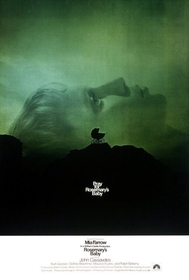Our editor-in-chief Nate Yapp is proud to have contributed to the new book Hidden Horror: A Celebration of 101 Underrated and Overlooked Fright Flicks, edited by Aaron Christensen. Another contributors include Anthony Timpone, B.J. Colangelo, Dave Alexander, Classic-Horror.com's own Robert C. Ring and John W. Bowen. Pick up a copy today from Amazon.com!
Rosemary's Baby (1968)
Most of the time, I make the mistake of reading a book and then heading out to see the movie because I was so excited by the book, only to discover a really different (and often not as good) story than I was expecting to see. With Rosemary's Baby, it happened a little differently. I loved director Roman Polanski's Chinatown, and was browsing the horror aisle when I happened upon this film. I took it home and ended up buying my own copy. Later, upon reading Ira Levin's book of the same name, I was delighted to discover that Mr. Polanski had remained extremely true to the story.
Rosemary's Baby is about a young couple, Guy and Rosemary Woodhouse, who take an apartment in a beautiful old building (played by the infamous Dakota in the film, where John Lennon lived and was shot) that has a rather evil history. Rosemary (Mia Farrow) becomes pregnant, and convinced that a coven is trying to steal her baby. We, of course, know better. The truth is much worse than that.
Mia Farrow's performance is strong. She convinces us she is a slightly modern young woman who has a little bit of trouble reconciling her more modern ideals with her Catholic upbringing. She is demure and a little naïve, picking out furniture and painting walls for her first apartment with her husband Guy (John Cassavetes), trusting him implicitly in spite of some rather glaring character flaws.
The only time she is unbelievable is when she finds out she is pregnant. Something about the way she reacts comes off as unnatural, but maybe that's her subconscious talking. Perhaps, we are not supposed to believe her. We are almost forced to come to a difficult conclusion -- that Rosemary was deliberately picked because of her struggle between her modern and Catholic identities. A stricter Catholic would not lie to get out of another lease, and a slightly more confident modern woman might deal more directly with these issues. Perhaps even going so far as to kill herself, or the baby growing inside her. Poor split Rosemary is frozen in the middle. Unable to face what has happened to her, she pretends that the evil is outside of her little apartment.
Ruth Gordon plays Minnie Castevet, the possibly witch-y but definitely nosy neighbor to Guy and Rosemary. She steals the show. She won a Golden Globe and an Oscar in 1969 for her performance, and both awards were well deserved. She is pushily hospitable, wedging her way into their apartment and their lives. The thing that is so fantastic about her performance is that we have all met a lady like her at some church function or similar event. Rosemary reacts to Minnie just the way we expect her to, smiling and waving while looking for a way out. At the climax of the story, which is actually a bit purposefully anticlimactic, Minnie makes the sinister all the more so by rubbing a spot out on the carpet. This little bit of domesticity is disturbing and a little bit funny because it is so like Grandmas cleaning grandkids' faces with spit. She is what we know.
This movie is not about trying to fool you. The horror is in knowing that there is nothing Rosemary can do and waiting for her to smell the coffee. For Rosemary, the horror lies in the mundane. Paced slowly in that 1960s kind of way, the movie has the feel of everyday life. The scariest moment for me happens in an ordinary way, in the background of a telephone call. Just like a refrigerator light bulb makes all the difference in Wait Until Dark, a closet makes all the difference here. Even though we know the big thing, the little things that are set up for us from the beginning make our skin crawl.
Polanski himself is almost a background character to this film. He uses under lighting to set the tone of this film. Even at its brightest, the setting seems unnatural. We feel a bit uneasy, never really able to become comfortable in this beautiful building. He uses the ordinary things of life to slip in important information. The witches track Rosemary's fertility cycle through casual conversations. We first hear the sounds of the coven through the walls of the Woodhouse's apartment. Rosemary and Guy laugh about it together in bed, not knowing what they are hearing.
Once, during filming, Polanski came to Ira Levin and asked which issue of The New York Times contained an ad mentioned in the book. Levin had almost been embarrassed to say that he had made it up. That sort of care shows here. These days, we live in a society where the movie is never the book and just never quite makes the mark. It is refreshing to watch a movie that captures not only the plot line but also the nuances of a work of fiction.
Trivia:
Mia Farrow received her divorce papers from Frank Sinatra on-set.
Producer William Castle makes a cameo as a man outside a phone booth.









